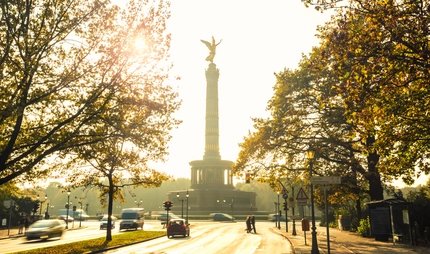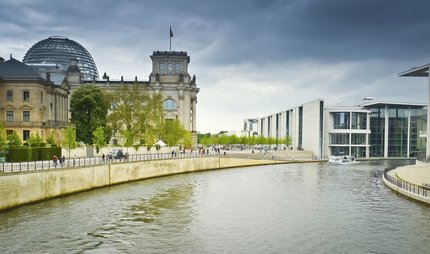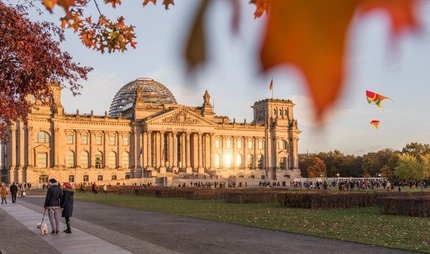
Schloss Bellevue
The modest seat of power
From Theodor Heuss to Frank-Walter Steinmeier – all of them have resided here while in office, because Schloss Bellevue is the seat of the Germany’s president.
Art historians have long argued about the palace architecture – is it still Baroque or is it already Neoclassical? These days, the architecture of the three-winged, two-storey palace is classed as Early Neoclassical. A compromise, in other words. Clear lines without much embellishment – the typical features of a seat of power, but still the building is rather uncharacteristic. But why not make up your own mind?
A residence for princes and celebrities
Schloss Bellevue was commissioned in 1785 by Prince August Ferdinand of Prussia. The white building in the northern part of the Tiergarten was completed two years later. At that time, there was only one side wing along with the main building. The property was used by Frederick the Great’s youngest brother as a residence and was not intended for show. It was characterised by its simplicity, but stood out with one of the finest landscape gardens of the time. The guest list featured many famous personalities: the German poet and dramatist Friedrich von Schiller and the French ruler Napoleon Bonaparte both visited the prince at his residential palace.
The precursor of the National Gallery
Several decades and Prussian kings later, the palace was converted to an art museum known as the Vaterländische Galerie. From 1844, contemporary Prussian works were exhibited in the rooms on the ground floor. King Friedrich-Wilhelm IV allowed the public access to the palace gardens. After 21 years, the artworks moved out again and the palace was used by the Prussian imperial court, housing royal gardeners, maids, cooks, grooms, valets, gamekeepers and saddlers.
The palace survived the first world war unscathed and passed into the possession of the Weimar government. It was used to house state visitors and thus, for the first time, as a representative building. It was less fortunate during the second world war – apart from a few exterior walls, the whole palace was reduced to ruins.
From the White House back to Berlin
The palace in the Tiergarten was rebuilt from 1955 to 1959. During this time, the German parliament declared it the second seat of office and residence of the President, who until then had only resided at the Villa Hammerschmidt in Bonn. In a slightly late response to Germany's reunification, the Bundespräsident moved to the capital permanently in 1994.
Richard von Weizsäcker “swapped” the order of the president’s seats of office and residence. Since then, Schloss Bellevue in Berlin has been the president’s primary home, and the “White House of Bonn” has been relegated to second place. As big and beautiful as the palace may be, most presidents prefer not to move privately into Bellevue with its view of the Spree. The palace is used for New Year’s receptions, and for state and inaugural visits. Once a year there is an open day, when the general public are invited to visit, and for just one day feel like princes and princesses, kings and queens, or presidents.
The ancient– the flag that flies outside Schloss Bellevue – is taken down when the president is at his residence in Bonn, on a trip abroad or visiting another Bundesland.



